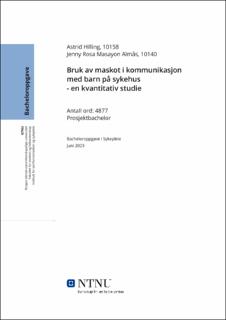| dc.contributor.advisor | Mary-Elizabeth, Eilertsen | |
| dc.contributor.author | Hilling, Astrid | |
| dc.contributor.author | Almås, Jenny Rosa Masayon | |
| dc.date.accessioned | 2023-07-15T17:21:36Z | |
| dc.date.available | 2023-07-15T17:21:36Z | |
| dc.date.issued | 2023 | |
| dc.identifier | no.ntnu:inspera:146721298:147643695 | |
| dc.identifier.uri | https://hdl.handle.net/11250/3079452 | |
| dc.description.abstract | Sammendrag
Introduksjon
Barn er en sårbar og kompleks pasientgruppe. Kommunikasjon og sykepleie som gis må være alderstilpasset slik at barnet forstår situasjonen og informasjonen som gis. Sykehusets barneavdeling innførte nylig en maskot, kosedyret Gusse Grevling, som et kommunikasjonsverktøy i møte med barn. Gusse benyttes av sykepleierne i kommunikasjon med barnet for å trygge, og forebygge bruk av tvang. Studiens hensikt er å undersøke sykepleierens erfaringer med bruk av maskot i kommunikasjon med barn, med spesielt fokus på trygghet.
Metode
Data ble innsamlet gjennom kvantitativ metode og anonym digital spørreundersøkelse. Undersøkelsen ble gjennomført på en barneavdeling ved et universitetssykehus i Norge. Data fremstilles i tabeller, analytisk tekst og statistiske utregninger. Data ble analysert i Excel.
Resultat
Studien har en svardeltakelse på 41%. Resultatene viser at respondentene som har brukt Gusse (50%) stort sett er fornøyd med bruk av Gusse i kommunikasjon, men en del av sykepleierne svarer nøytralt. Sykepleierne oppgir flere grunner for at de ikke har benyttet Gusse. Gusse benyttes i hovedsak i forbindelse med prosedyrer og undersøkelser, og som emosjonell støtte for barn.
Konklusjon
Sykepleierne erfarer Gusse som nyttig i kommunikasjon, og flere erfarer god effekt av Gusse i opplevelsen av trygghet hos barn. Det er usikkert om Gusse har bedre effekt enn andre metoder. Sykepleierne er enige om at Gusse fungerer bedre enn andre kosedyr. Studien viser at bruk av Gusse kan øke sykdomsforståelse, tillit og redusere engstelse som påvirker barnets trygghetsfølelse. Mer forskning vil være nødvendig for å si noe om den totale effekten og bruken av Gusse. | |
| dc.description.abstract | Abstract
Introduction
Children are a vulnerable and complex patient group. Age-appropriate communication and nursing should be provided to children, in order for them to understand their situation and the information given. The children’s ward at the hospital recently implemented a mascot, the stuffed animal Gusse the Badger, as a communication tool for children. Nurses use Gusse in communication with the child to increase safety and reduce involuntary constraints on children. The purpose of this study is to explore nurses' experiences using mascots when communicating with children, focusing especially on sense of safety.
Method
Data was collected through a quantitative method and an online anonymous survey. The survey was conducted at a children's ward at a university hospital in Norway. Data is visualized using tables, analytic text, and statistical calculations. Data was analyzed through Excel.
Results
Total participation from the ward was 41%. The results show that those who have used Gusse (50%) are overall satisfied with Gusse used in communication, however some respondents remain neutral. The nurses state multiple reasons for not using Gusse. Gusse is mainly used in procedures and examinations, and as emotional support for children.
Conclusion
The nurses consider Gusse as useful in communication, and several have experienced positive effect of Gusse in evaluation of children's sense of safety. It is uncertain if the effect of Gusse is better than other methods. The nurses agree that Gusse works better than other stuffed animals. This study shows that using Gusse can increase knowledge about healthcare and illness, trust and reduce anxiety which influences children’s sense of safety. Further research is necessary to describe the total effects and use of Gusse. | |
| dc.language | nob | |
| dc.publisher | NTNU | |
| dc.title | Bruk av maskot i kommunikasjon med barn på sykehus
- en kvantitativ studie | |
| dc.type | Bachelor thesis | |
